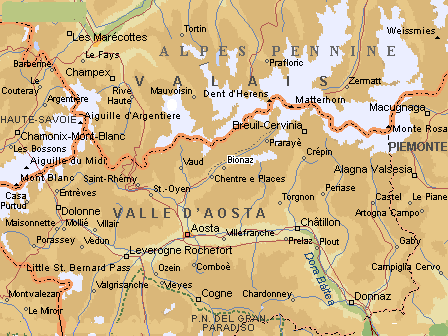BIONAZ VALLE D'AOSTA ITALY

Just where is Bionaz, Valle D'Aosta, Italy? Well about 2 years ago I found myself asking that same question, since then I have discovered this beautiful valley with its lovely hidden towns. The area is truly an unspoiled paradise with glacier blue lakes and towering snow capped mountains. I have also learned that Bionaz is pronounced Biona (the z is silent). The name Bionaz is mentioned for the first time in 1227 when a rental contact of a piece of land belonging to the Bishop was recorded. It is not known if the area was inhabited before the Middle Ages, but it is known that there was a community living there during the upper Middle Ages.
To Bionaz also came some Walser populations of German descent, they had to settle down in the upper part of the valley. The merchants of Herens, in the Vallais area, had a reserved spot in the Aosta market, which they reached by crossing the Col Collon mountain pass. At that time a warmer climate allowed crossing the mountains for a longer period out of the year than now. Through those business contracts, the Bionaz territory and its valley became a well known communications path. The prestigious family of the lords of Quart, feudatory of the area, owned in nearby Oyace a tower, called "Tornalla", which existed during the XII century.
The Bionaz territory belonged to the parish district of Valpelline until 1640. On July 29th of that year, the Bishop Mons. Vercellin, upgraded the status of the St. Margherita chapel (built in 1617) to that of parish church. The building is located in the Plan-de-Veyne village that became in the same year the administrative center of the area. The Bishops decision to appoint a parish priest in Bionaz to perform the liturgical functions was motivated by the limited and dangerous road connections, by the great amount of snow, and by the distance from the Valpelline parish church. In 1795, two distinguished French churchmen, the Archbishop of Paris Leclerc de Jung and Clermont Bishop Francois de Boveto, escaping the revolutionary upheaval, found shelter in the Bionaz mountain area. The crossed the Col Collon mountain pass, came to the Lechere hamlet, spent a few months there and were highly regarded by the local dwellers.

What is our family interest in this valley? well it's really very simple, Bionaz is the maiden name of my husbands mother Elizabeth Joan Bionaz Baker. Her family originates from this area and emigrated into the United States in the late 1890's. Initially the family lived in Pennsylvania, but eventually they wound up in Northern California, which is where my husband and his mother were both born.
To date we have been able to trace the Bionaz line back to Peter Bionaz, who was born in about 1842 in Gignod, Aosta, Italy, he was married to a woman named Duchia and they had a son John Elere Bionaz. He emigrated into the United States and in 1900 in Johnston, Pennsylvania he married Orpheline Mary Boche. John and Orpheline had four children and their son John Camel Bionaz is my husband grandfather.
Interest in this family name and one of my early web pages led a gentleman by the name of Jean Pierre Bionaz to our family. His grandfather Guiseppe-Umberto Bionaz also claimed this region as home and he was searching for any other Bionaz relatives he could find. During the past two years we have shared family information and are seeking the link to join our two families together.
Jean-Pierre also has a web site up, so please stop by
"Bionaz" and tell him I sent you.

Origins of the name BIONAZ
During my search for family information I wondered about the origins of the name Bionaz, Jean Pierre, provided this explanation. The gaulois word ONNA, ONNE, ONNO is equivalent to the Latin UNDA = stirred up water, floating wave, in general "water flow" This gaulois word is verified in the Viennese glossary from the 5th century, the time when the Goths dominated the largest part of central Gaule (the old name for France)
In the Valley of Aosta are found the toponymes BIONAZ, HONE, written in a charter from 1253, published in the Atlas of Vicary of Aosta, VERDONNA (Oyace) VESSONA (Bionaz), etc. These are founded and looked at as preceding primitive cultures in ONNA signifying "mouth of the river flow"
F. Krutwig in "Liguna Arpitana" gives the toponyme BIONAZ and the following explanation:
BI= two
ONA= water
This map gives a better perspective of where Bionaz is located. I have found many genealogist researching Italy but very few in the Valle D'Aosta Province.
The province of Aosta is located in the extreme northwestern portion of Itay near the French and Swiss borders.

Jean-Pierre continues to search for any and all Bionaz family members. Recently he turned up several new American family members, including a descendant of Amelia Boche my husbands great grandmother Orpheline Boche's sister. Both Boche sisters married men named Bionaz, who were not brothers but may have been cousins. The puzzle still continues to unfold and any and all clues are appreciated. If you recognize this name, drop us a line, by clicking on my name below.
Copyright © 1997 by Lisa Baker - All rights
reserved.
Back to Baker Roots



